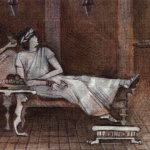
Why Rheumatology and the Care of Patients with Rheumatic Diseases are Important, Interesting, and Exciting
I recently introduced our all-too-brief, three half-days course on rheumatology and musculoskeletal diseases for first-year medical students, the only formal didactic education they would get from us during their four years. I gave a great deal of thought to how to present us and our discipline in my 15 minutes. Here is essentially what I told them. As academic rheumatology departments across the country are now interviewing and ranking potential new fellows and students and residents contemplate their career choices, my distillation may be of interest.
I believe that rheumatology and rheumatologists are special. Our discipline attracts physicians with a passion for patient care, deep humanity, intellectual curiosity, and distinctly good clinical skills who are extremely collegial, and who have contributed enormously to medicine. Let me present my top ten reasons why rheumatology is important, interesting, and fun.
10. Arthritis and related disorders are ubiquitous.
- They are the leading cause of disability in our society.
- They are the leading cause of complaints bringing patients to physicians’ offices in the United States.1
- They affect nearly 120 million Americans. It would be impossible for a caring, informed, and responsible medical school graduate to not have familiarly with rheumatic and related diseases.
9. Rheumatic diseases can be severe and serious.
- They impose a huge economic, social, and human burden to our society.
- They are not necessarily trivial. The notion of, “Oh, it’s only arthritis,” is incorrect, unacceptable, and intolerable. For example, rheumatoid arthritis (RA) may carry a worse prognosis than certain forms of malignancy and ischemic heart disease. Systematic rheumatic diseases kill. Others shorten lives, destroy quality of life, erode dreams, disrupt families, diminish earnings, reduce independence, and impair social and sexual relationships.
- We are making exciting progress toward our goals of treatment—restoration and preservation of physical and financial independence, diminution or ablation of symptoms, and ultimately retardation, reversal, cure, or prevention of disease. We have deep insights into disease etiopathogenesis and many novel and highly effective therapies. For example, we cure Lyme disease. We cure symptoms of gout. Patients with RA and lupus live far longer and better lives than they did only scant years ago.
8. He who knows rheumatic diseases knows a very great deal.2
- •Rheumatic diseases span medicine.
- •For us to properly care for our patients with lupus, vasculitis, RA, fibromyalgia, or even back and neck pain, we must know general medicine, geriatrics, neurology, cardiology, pulmonology, endocrinology, gastroenterology, dermatology, nephrology, hematology, orthopedics, ophthalmology, psychiatry, sometimes pediatrics and adolescent medicine, pharmacology, immunology, biochemistry, physiology, microbiology, pathology, rehabilitation, clinical psychology, pain management, and clinical therapeutics.

7. Diagnosis and differential diagnosis are challenging.2
- There are hundreds of entities to consider, requiring uncommon knowledge, judgment, and discernment.
- How do we confidently differentiate acute Lyme disease from Still’s disease from lupus from Weber-Christian disease from vasculitis from atrial myxoma? Crystal-induced from infectious arthritis? Innocuous back pain from spondyloarthopathy from metastatic cancer? Recrudescence of lupus from superimposed infection? Pain due to malignancy from that of rheumatic disease from that of psychological distress? We confront these questions every day—and we must be right because the treatments are radically different. It’s not easy, but it’s always challenging, humbling, and fun. With experience comes the necessary wisdom. That, combined with thoughtful, informed evaluations, leads to the correct care.
6. Rheumatic diseases offer fascinating research challenges and opportunities.2 Rheumatologists can do anything.
- We do epidemiology, sociology, clinical psychology, clinical therapeutics, pain, sports medicine, osteoporosis, prevention, clinical trials, molecular genetics and biology, basic immunology, cell biology, microbiology, neuro-immunology, bone and cartilage biology, and drug discovery.
5. There are incredibly diverse career opportunities.2
- Rheumatologists are clinicians, educators, investigators, administrators, in academia (a disproportionate number are department chairs and deans), at the NIH, in industry, in pharma, in bio-tech, in government, in world health, in business, and in combinations of these.
4. I’ve always thought that rheumatologists and rheumatic disease patients are special in certain ways.2,3
- It is a constant wonder how brave and stoical most rheumatic disease sufferers are.
- It takes a special disposition and perspective to serve these patients. Rheumatologists offer to share in the predicament of others. We seek wisdom when certainty is elusive. We cultivate patience, humanity, empathy, altruism, and tolerance of uncertainty. We aspire to be knowledgeable, thoughtful, responsive, ethical, and compassionate in today’s complex world. We accept realities and prepare for and adjust to tomorrow’s changes. We attempt to preserve the best of our traditions and to develop new strengths to successfully meet the future. We never lose sight of our categorical responsibility to do the good thing, care well for our patients.
- Rheumatologists are unusually congenial and collaborative colleagues.

3. Rheumatology is a uniquely clinical yet scientific and intellectually challenging discipline.2,3
- Rheumatology has contributed enormously to our current understandings of immunology and molecular biology and genetics. It has contributed enormously to bringing these discoveries to the “bedside” and patient care (e.g., biologic therapies). For example, rheumatology identified, described the clinical and immunopathologic features of, created diagnostic tests for, found treatments for, and ultimately developed a vaccine for and cured a new disorder: Lyme disease. This was an extraordinary example of applying contemporary science to understand clinical medicine. Clinical rheumatology is increasingly advanced by cutting-edge science.
- Rheumatology is one of those disciplines where the art and science of medicine come together.
- Rheumatologists seem preferentially drawn to this cognitive-based specialty particularly because of the intellectual challenges.4 Historically, rheumatology attracted the best and the brightest. The good rheumatologist models a scholarly, humanistic approach to medicine, but he or she will appreciate that clinical rheumatology at the bedside remains inherently a clinical exercise, that good medicine uses science to inform art. Rheumatologists love the immediacy of our specialty, the ability to understand by talking to and touching patients. They take special pride that their refined clinical skills remain indispensable. The good rheumatologist will usually reach a diagnosis following a careful, learned, thoughtful evaluation, and will know that he or she has a full array of modern diagnostic studies available, but will need and use them sparingly. “In clinical rheumatology, science does not often substitute for art nor sophisticated technology for diagnostic acumen.”5 The good rheumatologist knows science and will wisely integrate appropriate advances into patient care. He or she knows that the essence of medicine is the reduction of uncertainty, but tolerates uncertainly and helps his or her patients accept it. Good rheumatologists will care for patients with passion, respect, and humane understanding. They know “the secret of the care of the patient is in caring for the patient.”6
2. Rheumatic diseases changed history.
- Gout led to the fall of the Roman Empire.7
- Sir William Pitt’s gout led to the American Revolution.8
- The Tsaravich Alexander’s episode of hemophiliac arthritis led to the fall the Romanov Tsardom and nearly a century of communism in Russia.9
- Temporal arteritis may have contributed to Hitler’s madness and the resultant incalculable suffering and apocalyptic tragedy.10
- The lupus of Millie (the springer spaniel) confounded and tainted Bush’s presidency.11,12

1. And, finally, the number-one reason rheumatic diseases are important is that patients with rheumatic diseases enrich our lives and remind us of the triumph of the human spirit. We learn courage, perseverance, optimism, mindfulness, perspective, humility, and humanity from our patients.
- Conceive of the triumph of Michelangelo painting the Sistine ceiling with his arthritis, probably gouty, and perhaps osteoarthritis, too.13
- Enjoy the great art of Peter Paul Rubens, who suffered with and depicted RA.14
- Deforming, disabling gout influenced the work of Jean-Baptiste-Camille.15
- Pierre-Auguste Renoir developed terrible, advanced, crippling, incapacitating RA.16 Yet, unable to reach, barely able to lift, with a limited palette, in pain, he said, “In the battle I have lost my legs, I cannot sit, get up, or take a step without being helped … I am so lucky to still have painting which, even very late in life, still offers illusions and sometimes joy.” Inspiring.
- Frida Kahlo’s life was tragic.17 She may have had lupus and/or antiphospholipid antibody syndrome together with fibromyalgia, yet she painted wonderfully and was honored with international recognition. Trotsky (with whom she had an affair) said that “she painted the human condition—alone and in pain,” a depressing thought, but a reality for many of our patients.
- Paul Klee died young of his systemic sclerosis. The Journal of the American Medical Association recently featured his brooding, emotional, anguished work, which included “tod” (death) spelled out, on its cover.18 This was reflective of his artistic expression of the relentless progression of his soon-to-be fatal disease.19
- More recently, Raoul Dufy, a modernist, developed severe RA just at the time cortisone was synthesized (by a rheumatologist who, with his collaborators, was awarded the Nobel Prize in Physiology or Medicine). Dufy was one of the first patients offered this miraculous medication. He improved dramatically and returned to productive painting. One of his more interesting works is titled “Cortisone,” reflecting the dramatic difference in his ability to paint before and after starting his new medication.20 (Unfortunately, he died not long after of a gastrointestinal hemorrhage; this is sometimes associated with steroid use.)
I hope I have suggested to you how rheumatology and rheumatic diseases are important, of interest, and can be fun. Whatever you do, reflect on the words of a bronze plaque encountered upon entering the Palestra, the historic Philadelphia basketball arena at the University of Pennsylvania: “To win the game is great. To play the game is greater. But to love the game is greatest of all.” Love, and respect, what you do.


